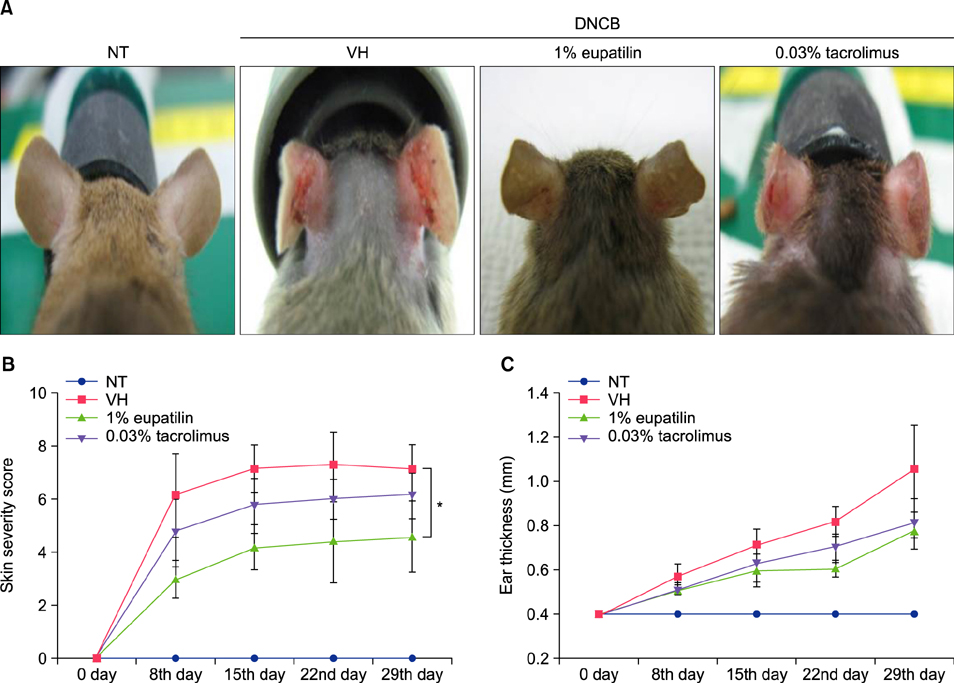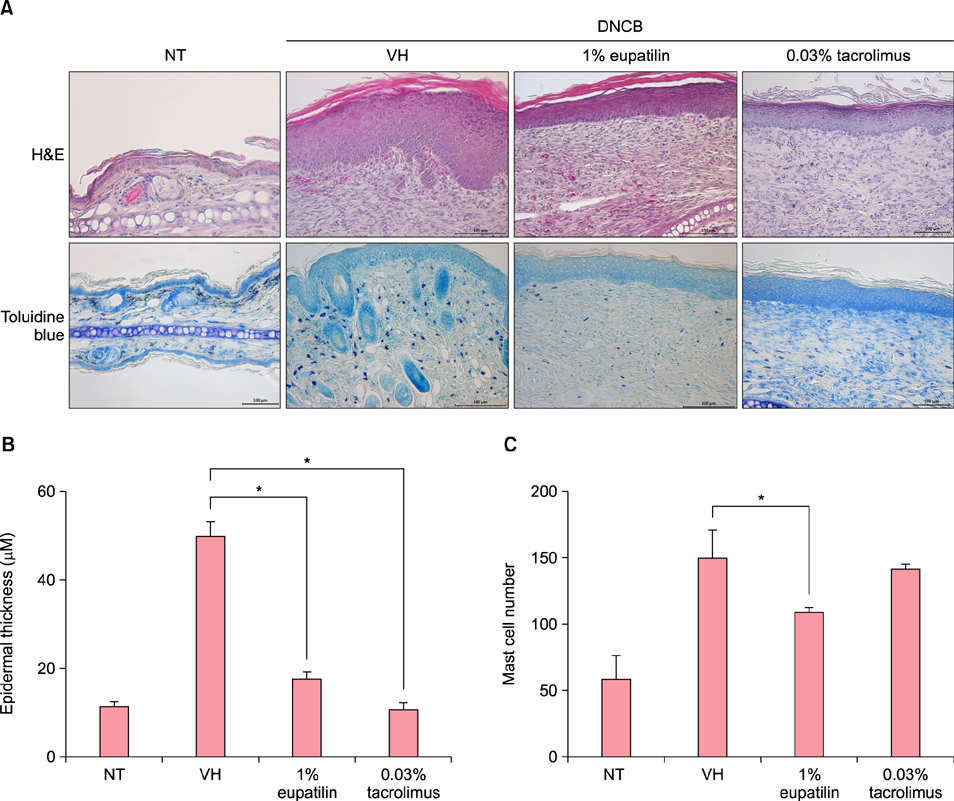Ann Dermatol.
2017 Feb;29(1):61-68. 10.5021/ad.2017.29.1.61.
Topical Application of Eupatilin Ameliorates Atopic Dermatitis-Like Skin Lesions in NC/Nga Mice
- Affiliations
-
- 1Department of Dermatology, Seoul St. Mary's Hospital, College of Medicine, The Catholic University of Korea, Seoul, Korea. yymmpark6301@hotmail.com
- KMID: 2368029
- DOI: http://doi.org/10.5021/ad.2017.29.1.61
Abstract
- BACKGROUND
Atopic dermatitis (AD) is an inflammatory skin disorder with severe pruritus. Despite advancements in medicine, therapeutic treatments for AD are still limited. Eupatilin (5,7-dihydroxy-30,40,6-trimethoxyflavone) is one of the lipophilic flavonoids from Artemisia umbelliformis Lam. and Artemisia genipi Weber.
OBJECTIVE
Although it has been reported to act a role in improving inflammation, its action on AD is uncertain. In this study, we examined the role of eupatilin on AD-like skin lesions in NC/Nga mice.
METHODS
2,4-dinitrochlorobenzene was repeatedly applied to the ear of NC/Nga mice to produce AD-like skin lesions. Eupatilin (1%, once a day for 5 consecutive days/week) was applied topically for four weeks for the evaluation of its therapeutic effects.
RESULTS
1% eupatilin cream significantly reduced the clinical severity score of AD-like lesions, compared to the vehicle (p<0.005). A histopathological analysis revealed that 1% eupatilin cream significantly decreased the mast cell infiltration as well as inflammatory cell infiltration, compared to the vehicle (p<0.005). We showed that 1% eupatilin cream significantly reduced the expression of thymic stromal lymphopoietin, tumor necrosis factor-α, interleukin-4, and interleukin-19, but not interferon-γ, compared to the vehicle (p<0.005).
CONCLUSION
Considering the therapeutic reaction of eupatilin on AD-like lesions as in this study, the substance has a promising to be an adjuvant topical agent for the control of AD.
Keyword
MeSH Terms
Figure
Cited by 1 articles
-
Effects of Eupatilin on Insulin-Like Growth Factor 1-Induced Lipogenesis and Inflammation of SZ95 Sebocytes
Ji Hyun Lee, Ye Jin Lee, Ji Young Song, Yeong Ho Kim, Jun Young Lee, Christos C. Zouboulis, Young Min Park
Ann Dermatol. 2019;31(4):479-482. doi: 10.5021/ad.2019.31.4.479.
Reference
-
1. Bieber T. Atopic dermatitis. Ann Dermatol. 2010; 22:125–137.
Article2. Bao L, Shi VY, Chan LS. IL-4 up-regulates epidermal chemotactic, angiogenic, and pro-inflammatory genes and down-regulates antimicrobial genes in vivo and in vitro: relevant in the pathogenesis of atopic dermatitis. Cytokine. 2013; 61:419–425.
Article3. Leung DY, Soter NA. Cellular and immunologic mechanisms in atopic dermatitis. J Am Acad Dermatol. 2001; 44:S1–S12.
Article4. Leung DY, Boguniewicz M, Howell MD, Nomura I, Hamid QA. New insights into atopic dermatitis. J Clin Invest. 2004; 113:651–657.
Article5. Blume-Peytavi U, Wahn U. Optimizing the treatment of atopic dermatitis in children: a review of the benefit/risk ratio of methylprednisolone aceponate. J Eur Acad Dermatol Venereol. 2011; 25:508–515.
Article6. Lee JH, Jung KE, Lee YB, Kim JE, Kim HS, Lee KH, et al. Use of emollients in atopic dermatitis: a questionnaire survey study. Ann Dermatol. 2014; 26:528–531.
Article7. Hengge UR, Ruzicka T, Schwartz RA, Cork MJ. Adverse effects of topical glucocorticosteroids. J Am Acad Dermatol. 2006; 54:1–15. quiz 16-18.
Article8. Choi EJ, Oh HM, Na BR, Ramesh TP, Lee HJ, Choi CS, et al. Eupatilin protects gastric epithelial cells from oxidative damage and down-regulates genes responsible for the cellular oxidative stress. Pharm Res. 2008; 25:1355–1364.
Article9. Lee S, Lee M, Kim SH. Eupatilin inhibits H(2)O(2)-induced apoptotic cell death through inhibition of mitogen-activated protein kinases and nuclear factor-kappaB. Food Chem Toxicol. 2008; 46:2865–2870.
Article10. Choi EJ, Oh HM, Wee H, Choi CS, Choi SC, Kim KH, et al. Eupatilin exhibits a novel anti-tumor activity through the induction of cell cycle arrest and differentiation of gastric carcinoma AGS cells. Differentiation. 2009; 77:412–423.
Article11. Lee SH, Bae EA, Park EK, Shin YW, Baek NI, Han EJ, et al. Inhibitory effect of eupatilin and jaceosidin isolated from Artemisia princeps in IgE-induced hypersensitivity. Int Immunopharmacol. 2007; 7:1678–1684.
Article12. Kim JY, Kwon EY, Lee YS, Kim WB, Ro JY. Eupatilin blocks mediator release via tyrosine kinase inhibition in activated guinea pig lung mast cells. J Toxicol Environ Health A. 2005; 68:2063–2080.
Article13. Jin H, He R, Oyoshi M, Geha RS. Animal models of atopic dermatitis. J Invest Dermatol. 2009; 129:31–40.
Article14. Fujii Y, Takeuchi H, Sakuma S, Sengoku T, Takakura S. Characterization of a 2,4-dinitrochlorobenzene-induced chronic dermatitis model in rats. Skin Pharmacol Physiol. 2009; 22:240–247.
Article15. Jung KE, Lee YJ, Ryu YH, Kim JE, Kim HS, Kim BJ, et al. Effects of topically applied rapamycin and mycophenolic acid on TNCB-induced atopic dermatitis-like skin lesions in NC/Nga mice. Int Immunopharmacol. 2015; 26:432–438.
Article16. Kim J, Kim Y, Yi H, Jung H, Rim YA, Park N, et al. Eupatilin ameliorates collagen induced arthritis. J Korean Med Sci. 2015; 30:233–239.
Article17. Kawakami T, Ando T, Kimura M, Wilson BS, Kawakami Y. Mast cells in atopic dermatitis. Curr Opin Immunol. 2009; 21:666–678.
Article18. Kitagaki H, Fujisawa S, Watanabe K, Hayakawa K, Shiohara T. Immediate-type hypersensitivity response followed by a late reaction is induced by repeated epicutaneous application of contact sensitizing agents in mice. J Invest Dermatol. 1995; 105:749–755.
Article19. Leonard WJ. TSLP: finally in the limelight. Nat Immunol. 2002; 3:605–607.
Article20. Soumelis V, Reche PA, Kanzler H, Yuan W, Edward G, Homey B, et al. Human epithelial cells trigger dendritic cell mediated allergic inflammation by producing TSLP. Nat Immunol. 2002; 3:673–680.
Article21. Homey B, Steinhoff M, Ruzicka T, Leung DY. Cytokines and chemokines orchestrate atopic skin inflammation. J Allergy Clin Immunol. 2006; 118:178–189.
Article22. Bao L, Alexander JB, Shi VY, Mohan GC, Chan LS. Interleukin-4 up-regulation of epidermal interleukin-19 expression in keratinocytes involves the binding of signal transducer and activator of transcription 6 (Stat6) to the imperfect Stat6 sites. Immunology. 2014; 143:601–608.
Article23. Myles IA, Fontecilla NM, Valdez PA, Vithayathil PJ, Naik S, Belkaid Y, et al. Signaling via the IL-20 receptor inhibits cutaneous production of IL-1β and IL-17A to promote infection with methicillin-resistant Staphylococcus aureus. Nat Immunol. 2013; 14:804–811.
Article24. Bieber T. Atopic dermatitis. N Engl J Med. 2008; 358:1483–1494.
Article25. Rudikoff D, Lebwohl M. Atopic dermatitis. Lancet. 1998; 351:1715–1721.
Article
- Full Text Links
- Actions
-
Cited
- CITED
-
- Close
- Share
- Similar articles
-
- Developing an Atopic Dermatitis Model and the Effects of Actinidia Extract on Dermatitis in NC/Nga Mice
- Therapeutic Effects of Light Emitting Diode on Atopic Dermatitis-Like Lesions in NC/Nga Mice
- A Novel Model for Human Atopic Dermatitis: Application of Repeated DNCB Patch in BALB/c Mice, in Comparison with NC/Nga Mice
- Effects of CpG Oligodeoxynucleotide on Airway Inflammation after Topical Application of and Airway Challenge with Dermatophagoides farinae in NC/Nga Mice
- A Study on Tests of Skin Safety and Inhibition of Atopic Dermatitis Using a StoneTouch(R) Infrared Scanner in a Mouse Model





